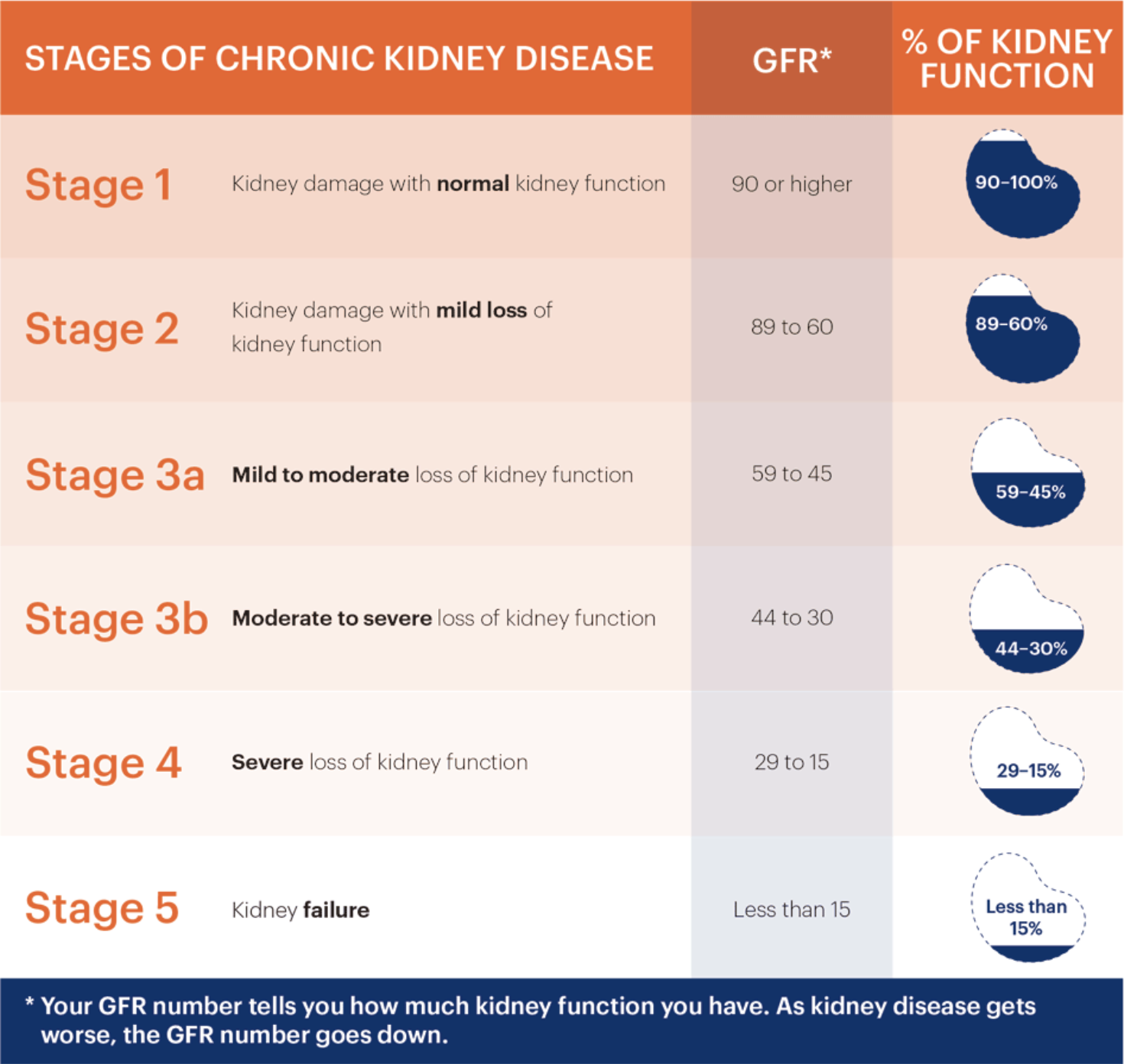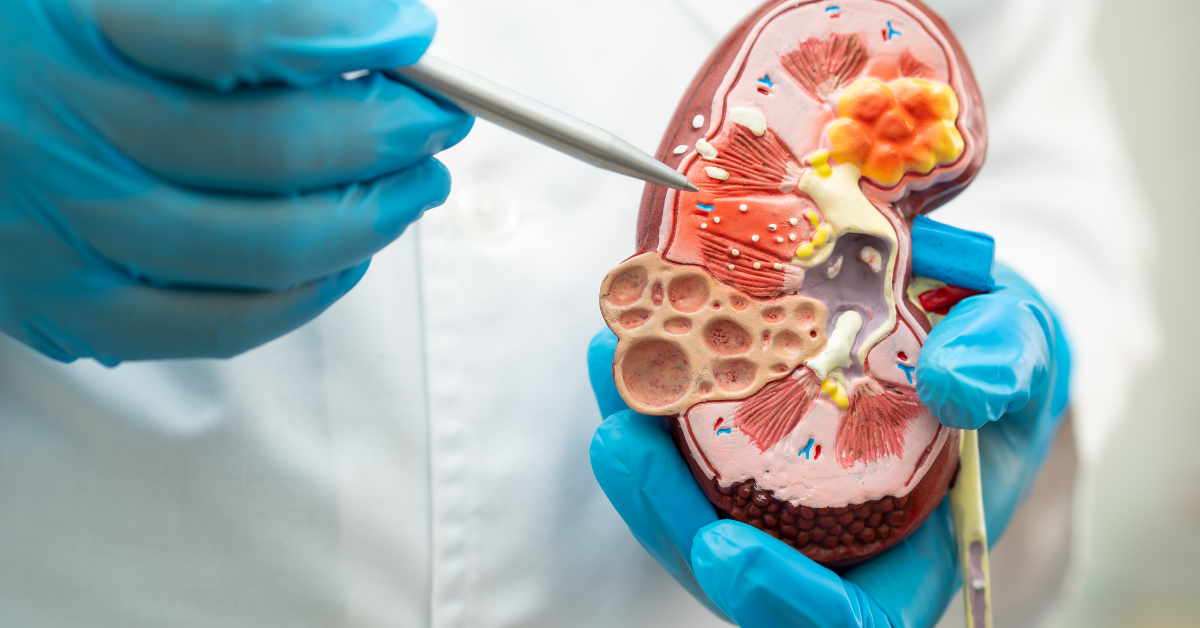Explore the intricate world of kidney health and discover actionable tips to nourish these vital filters. Dive into the importance of a kidney-friendly lifestyle, supported by evidence-based insights.
The urinary system filters waste products and excess water from the blood, producing urine to remove them from the body [1]. Your kidneys play a crucial role in maintaining the right balance of fluids and electrolytes in the blood, which is essential for overall health. The kidneys also filter and regulate electrolytes like sodium, potassium, and calcium, ensuring they stay within healthy ranges in the blood. Hormones (like renin) are produced by the kidneys and help regulate blood pressure by controlling blood volume and sodium levels. Erythropoietin (EPO), another hormone made by the kidneys, stimulates the bone marrow to produce red blood cells, addressing oxygen levels in the body. The kidneys also play a role in converting inactive vitamin D into its active form (calcitriol), which is essential for bone health and calcium absorption. Lastly, the kidneys regulate the pH of the blood by excreting excess acids or bases, maintaining a stable and healthy acid-base balance.
Tips for Kidney Health
Your kidneys work hard to filter waste and maintain fluid balance, so supporting them with healthy habits is essential. This is nothing more than you already know, but, life gets to life-ing and sometimes we fall off track, so here’s a good reminder of the basics.
Staying well-hydrated is key—aim for about 6–8 glasses of water daily to help your kidneys function optimally [2]. This is especially important if you’ve been eating salty foods (takeout meals, canned goods like beans) or have been sweating profusely. Not everyone loves glugging down plain water, so check out some other ways to get your hydration on.
Eating a nutrient-rich diet filled with fruits, vegetables, whole grains, and lean proteins can also support kidney health. However, be mindful of excessive salt and highly processed foods, as they can increase strain on the kidneys. Not-so-fun fact: more than 75% of American sodium intake comes from outside foods [3]. It’s totally fine if you can’t make all of your meals from scratch or even if you can’t include whole foods in the majority of your meals; so click here to learn how to be a savvier consumer when it comes to dining out and here to learn how to read a Nutrition Facts Label.
If you have a family history of hypertension or cardiovascular disease—or experience chronic stress due to your work or lifestyle—keeping your blood pressure in check is especially important for reducing the risk of kidney disease. Not too long ago, I shared my story about managing my own blood pressure issues, which I continue to do to this day. Click here to learn more about what worked for me (and what may work for you).
Regular physical activity, such as walking, cycling, or strength training, can further support kidney function by promoting overall cardiovascular health and reducing inflammation.
Anyone with a formal diagnosis or risk of kidney disease may need to modify food and fluid, which will be discussed further below.
Understanding Chronic Kidney Disease
Chronic kidney disease (CKD) often progresses silently, showing few symptoms until advanced stages. Diabetes and high blood pressure are the leading causes of kidney disease, which is why it is essential that you maintain regular check-ups if you have been diagnosed with either—or both—to be sure your condition is not advancing too quickly.
For the purpose of understanding chronic kidney disease (CKD) stages, you can think of your kidneys like large balloons. At 100% full, they’re rocking steady, doing well, and performing all functions as they should. Once they begin to “deflate” (to 75% to 50% to 25% and so on), they become less and less able to maintain their normal function.

A kidney disease diagnosis can be challenging, from dietary restrictions to medication management, and navigating daily life with later-stage chronic kidney disease can be daunting [4]. Something as simple as a plate of vegetables might require modification to reduce the risk of progressing the disease, especially if you’ve been told to increase fiber or veggies to help with high cholesterol or high blood pressure (i.e., what works for one condition may conflict with the other). Dealing with kidney issues may require patience, strength, resilience, and support from loved ones and healthcare professionals.
Nutritional Strategies to Manage Kidney Disease
Fluid
When dealing with chronic kidney disease (CKD), and because your kidneys are responsible for excreting waste via urine, your healthcare providers might instruct you to monitor your water intake.
CKD Stages 3 and 4: Kidneys may struggle to excrete excess water, requiring limited fluid intake to prevent fluid buildup and maintain electrolyte balance [4].
CKD Stage 5/End-Stage Renal Disease (ESRD): For those on dialysis, fluid intake is significantly restricted because dialysis replaces kidney function but does not remove fluids as effectively as healthy kidneys [5]. Those with chronic kidney disease (CKD) stages 3 or 4, or kidney failure (CKD stage 5/end stage kidney disease), the kidneys aren’t functioning properly and are unable to perform excretion. In the case of someone undergoing dialysis, dialysis will do the work of the kidneys and water consumption will be greatly restricted.
The 3 Ps
In addition to managing sodium intake, foods containing protein, potassium, and phosphorus should also be monitored if you’re managing CKD to slow disease progression and prevent complications.
Protein needs vary based on the stage of CKD—while early stages may require moderate intake to reduce kidney strain, later stages or dialysis patients may need higher amounts to maintain muscle mass. Whether you are working with a primary care physician or a nephrologist, be sure that a Registered Dietitian is a part of your care team as they can help determine the right balance based on your individual needs.
High-potassium foods like bananas, oranges, potatoes, tomatoes, and spinach should be consumed in moderation for individuals with CKD, portion sizes adjusted based on lab results. Potassium is a key mineral that helps regulate nerve and muscle function, but it needs to be monitored in CKD since impaired kidney function can lead to dangerously high levels in the blood. In some cases, potassium binders or special food preparation methods, like leaching potassium from vegetables, may be recommended.
Reducing phosphorus intake is also crucial for individuals with kidney disease. Phosphorus, while an important micronutrient, can weaken bones and contribute to cardiovascular issues in excess quantities. Processed foods in particular—like fast food meals, canned drinks, spreadable cheeses, and baked goods—usually contain phosphorus additives and should be minimized, sometimes along with other high-phosphorus foods like dairy products, nuts, and seeds. Instead, individuals with CKD can focus on whole, minimally processed foods that support overall health while reducing strain on the kidneys. Working closely with a healthcare provider and a dietitian can ensure a balanced approach to nutrition that meets individual needs without compromising kidney function.
NOTE: Davita.com is a great resource that can provide you with a list of stage-specific recipes to make meal planning easier.
Keep in mind that understanding your blood test results—and whether or not your lab values are abnormal—is an important part of managing your disease since not every stage of CKD will automatically be associated with increased or decreased labs. Just like any condition, CKD can be highly individualized, so be sure to ask questions at every one of your office visits.
Other Common Kidney Issues
Kidney Stones & Urinary Tract Infections
Kidney stones and urinary tract infections (UTIs) are both conditions that affect the urinary system, but they differ in causes, symptoms, and treatments [7].
Kidney stones are hard mineral and salt deposits that form in the kidneys when urine becomes concentrated, allowing these substances to crystallize. Common risk factors include dehydration, high sodium intake, and certain medical conditions like gout or hyperparathyroidism. Symptoms of kidney stones often include severe pain in the lower back or side, blood in the urine, nausea, and difficulty urinating if a stone blocks the urinary tract. Treatment depends on the size and location of the stone—small stones may pass naturally with increased fluid intake, while larger stones may require medical intervention such as shock wave therapy or surgical removal.
Kidney stones may be prevented by staying hydrated and limiting foods high in oxalates, like spinach and nuts. Consuming adequate calcium can prevent the buildup of calcium in the kidneys, which can lead to stones.
NOTE: Remember that it’s the “dosage” that leads to the toxicity. Don’t cut out all of these oxalate-containing foods as they are very beneficial in so many other ways when it comes to a well-balanced diet; it’s more about putting some of the higher-oxalate foods on rotation and not overloading them in the course of many meals or many days in a row.
On the other hand, urinary tract infections (UTIs) are bacterial infections that can occur anywhere in the urinary tract, including the bladder or kidneys. They are often caused by bacteria like Escherichia coli (E. coli) entering the urethra and multiplying. Common symptoms include a burning sensation while urinating, frequent urges to urinate, cloudy or strong-smelling urine, and lower abdominal discomfort. If the infection reaches the kidneys, symptoms can escalate to fever, chills, nausea, and back pain. UTIs are typically treated with antibiotics, and prevention strategies include staying well-hydrated, maintaining proper hygiene, and urinating after sexual activity.
NOTE: Long-term use of antibiotics can significantly reduce the recurrence of UTIs, but may also lead to microbial resistance and increase the risk of side effects. In older adults, long-term antibiotic can also elevate the risk of hospitalization or emergency department visits for UTIs, so please discuss this with your doctor or pharmacist if you tend to manage chronic UTIs.
Despite their differences, kidney stones and UTIs share some overlapping symptoms, such as pain during urination, discomfort in the lower back, and changes in urine color or odor. In some cases, a kidney stone can even lead to a UTI by blocking urine flow and creating an environment where bacteria thrive. Because symptoms can sometimes mimic each other, proper diagnosis through urinalysis, imaging, or lab tests is crucial to ensure the right treatment approach.
The Importance of Kidney Screenings
Hypertension (high blood pressure) is one of the top 10 chronic conditions in the United States [6]. Persistent high blood pressure can strain the heart and blood vessels, increasing the risk of heart disease, stroke, and kidney problems. Regular health screenings are essential for detecting any potential kidney issues early on. Consider scheduling a check-up with your healthcare provider for:
- Blood Pressure Check: You can also pop into a local pharmacy test your blood pressure onsite to catch any abnormalities, or to purchase a cuff and test regularly at home.
- Kidney Function Test: Ask your doctor about tests like serum creatinine and glomerular filtration rate (GFR) to assess kidney function.
Kidney-Friendly Recipes
The recipes below are a great way to show your kidneys some love and should also be safe for all stages of CKD if you have been diagnosed (but please be sure to check with your doctor or dietitian to confirm).
- Quinoa and Vegetable Stir-Fry – a balanced, protein-packed dish using kidney-friendly ingredients.
- Baked Salmon with Lemon and Herbs – a low-phosphorus, high-protein meal that supports kidney health.
- Mediterranean Chickpea Salad – a flavorful dish rich in kidney-friendly nutrients and low in sodium.
- Cucumber Mint Water – a refreshing beverage that helps maintain hydration without added sugars.
- Berry Smoothie – a low-potassium, high-antioxidant drink perfect for kidney health.
Learn more about kidney health from our interview with renal specialists and Registered Dietitians Melanie Betz and Jen Hernandez:
Your Kidney Health Action Plan
No matter where you are in your life cycle, taking care of your kidneys is just as important as taking care of your heart for maintaining overall health and well-being. By following these tips and staying proactive with screenings, you can support your kidneys and reduce the risk of kidney disease.
- Schedule a health screening with your doctor today. Regular check-ups, including kidney function tests, can detect issues early.
- Stay hydrated by drinking at least eight glasses of water daily.
- Incorporate kidney-friendly foods into your diet, such as leafy greens, berries, and fish.
- If you have been diagnosed with or told you are at risk for diabetes and high blood pressure, make extra efforts to manage your blood sugar and blood pressure to avoid any future kidney issues.
- Consult with a Registered Dietitian (like me!) for personalized guidance since many doctors and healthcare specialists may not understand the nuance around patient-centered care when it comes to food and nutrition or how to provide you with a realistic and sustainable way to plan your meals, regardless if you have healthy kidneys or have been diagnosed with CKD of any stage.
- Share this post with friends and family to spread awareness about kidney health.
JOIN US!
If you’re reading this before April 10, 2025, click here to join our FREE, live webinar to learn more about the role and functions of our kidney, the stages of chronic kidney disease, and dietary guidelines that support kidney health and manage disease. As always, registrants will receive a link to the recording after the event, so don’t worry if you can’t attend the live event. Or you can head to our Wellness Webinar playlist on DishWithDinaTV to check out past events on similar topics.
References
- Anatomy of the Urinary System – https://www.hopkinsmedicine.org/health/wellness-and-prevention/anatomy-of-the-urinary-system
- 6 Tips To Be “Water Wise” for Healthy Kidneys – https://www.kidney.org/news-stories/6-tips-to-be-water-wise-healthy-kidneys
- Sodium sources: Where does all that sodium come from? – https://www.heart.org/en/healthy-living/healthy-eating/eat-smart/sodium/sodium-sources
- Stage 5 Chronic Kidney Disease (CKD) – https://www.kidney.org/kidney-topics/stage-5-chronic-kidney-disease-ckd
- Healthy Hydration and Your Kidneys – https://www.kidney.org/kidney-topics/healthy-hydration-and-your-kidneys
- Chronic diseases in America – https://www.cdc.gov/chronic-disease/about/index.html
- Diseases & Conditions: Kidney infections – https://www.mayoclinic.org/diseases-conditions/kidney-infection/symptoms-causes/syc-20353387



0 Comments